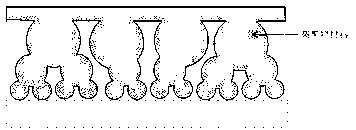Multiple-repeated butt joint method of spacecraft space
A technology for launching spacecraft and spacecraft, which is applied in the direction of docking devices for space navigation vehicles, etc., can solve problems such as collisions, and achieve the effect of improving flexibility and reducing difficulty.
- Summary
- Abstract
- Description
- Claims
- Application Information
AI Technical Summary
Problems solved by technology
Method used
Image
Examples
specific Embodiment approach 1
[0019] Specific implementation mode 1: In this implementation mode, gecko glue is used to realize the docking between tiny spacecraft, and the specific steps are as follows:
[0020] A layer of gecko glue containing nano-cilia is used to fix a layer on the surface of the flexible deployment device. The array direction of the gecko glue is outward, and the primary array of the gecko glue is distributed on the surface of the flexible deployment device. secondary array. After the flexible deployment device is deployed, when it comes into contact with the docking target, the gecko glue is bonded based on the intermolecular attraction, and the target spacecraft can be bonded together. When the spacecraft needs to be separated, the gecko glue can be easily peeled off from the surface of the spacecraft.
[0021] In this embodiment, the gecko glue uses the hydrogen bubble template method to prepare porous metal as a template, pours a high polymer, and takes out the template for prepa...
specific Embodiment approach 2
[0036] Embodiment 2: This embodiment differs from Embodiment 1 in that the butt joint is achieved by coating the surface of the flexible deployment device with a pressure-sensitive adhesive.
[0037] For the convenience of operation, the pressure-sensitive adhesive can be sealed into the microreactor (the microreactor is spherical, its size is 2-200 μm, and the thickness of the capsule wall is 10-20 μm), so that it does not have viscosity and the device is easy to store. Storing the flexible deployment device airtightly in the launch cabin of the spacecraft in a folded form ( Figure 5 ), after entering the predetermined track, open the airtight device, and stretch out the folded flexible deployment device ( Figure 6 ), exposed to vacuum, the microreactor ruptures, and the pressure-sensitive adhesive flows out, achieving bonding to the target ( Figure 7 ).
[0038] In this embodiment, the pressure-sensitive adhesive may be selected from, for example, acrylate pressure-sens...
specific Embodiment approach 3
[0040] Specific embodiment 3: The difference between this embodiment and specific embodiments 1 and 2 is that the reactive docking device is folded and stored airtightly in two spacecraft launch cabins that need to be docked at the same time during launch ( Figure 8 ).
PUM
 Login to View More
Login to View More Abstract
Description
Claims
Application Information
 Login to View More
Login to View More - R&D Engineer
- R&D Manager
- IP Professional
- Industry Leading Data Capabilities
- Powerful AI technology
- Patent DNA Extraction
Browse by: Latest US Patents, China's latest patents, Technical Efficacy Thesaurus, Application Domain, Technology Topic, Popular Technical Reports.
© 2024 PatSnap. All rights reserved.Legal|Privacy policy|Modern Slavery Act Transparency Statement|Sitemap|About US| Contact US: help@patsnap.com










